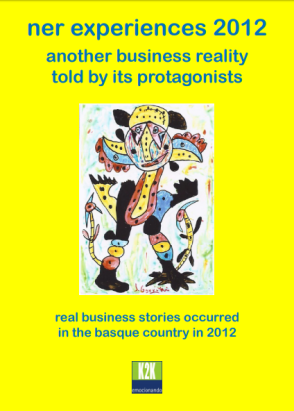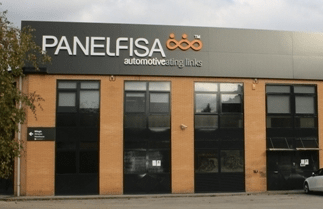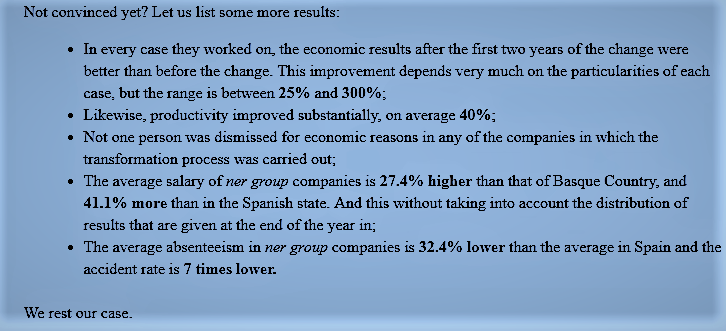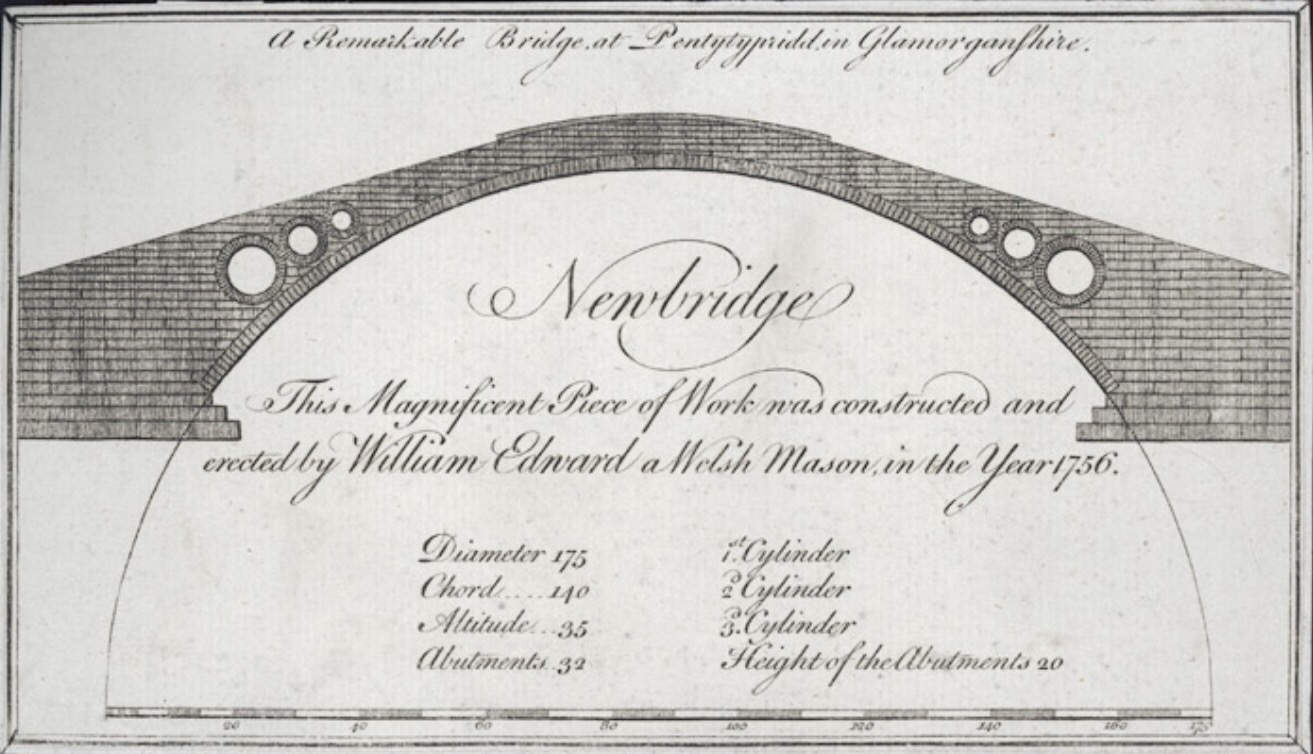 “Panelfisa Coop, The important thing was not the screws” This post is about the transformation (a deliberately chosen word) of Panelfisa, a worker owned industrial manufacturing cooperative in the Basque Country.
“Panelfisa Coop, The important thing was not the screws” This post is about the transformation (a deliberately chosen word) of Panelfisa, a worker owned industrial manufacturing cooperative in the Basque Country.
It’s not a ‘recipe book’ case study claiming… “follow these 5 easy steps and you too will transform your organisation”; life just isn’t like that. It’s about manufacturing widgets and sustainable human development, that might be a paradox for some – The Panelfisa Paradox.
Just to set the context, Panelfisa manufacture ‘fixings’, mostly for the automotive industry. These are screws that hold things together in everyday language, and it’s where the quote “the important thing was not the screws” comes from. Human relationships were the thing that really mattered here. The transformation of Panelfisa between 2010 and 2012 is explained in detail in the book: ‘ner experiences 2012 – another business reality told by its protagonists – real business stories that occurred in the basque country in 2012′.
I’m fortunate to have a copy, given to me by Pablo and Jabi at K2K Emocionando, but you can read an online copy if you wish (link here).
What can we learn from making widgets? I’ve deliberately used the term ‘widget’ here to make a serious point. Widget is a word that describes an ‘imagined small product made by a company’, often because people cannot describe the actual product, or sometimes to be dismissive. By using the word ‘widget’ some people are able to justify being unwilling to accept new ideas or different ways of thinking. I’ve often heard the phrase, “Ah… but that would never work here, they make widgets, we are dealing with complex human systems…”.
But guess what – there’s plenty to learn from Panelfisa. They might be the embodiment of clever engineering, sophisticated manufacturing and quality control (making millions of screws), but they are also a complex human system; the people who work there and the global network of customers they deal with.
 Why should you be interested in Panelfisa? Before I dive into the things I’ve learnt, here is a quick summary of the Panelfisa experience:
Why should you be interested in Panelfisa? Before I dive into the things I’ve learnt, here is a quick summary of the Panelfisa experience:
- They are a worker cooperative of approximately 80 people, based in the Basque Country, with activities worldwide.
- Their activity declined following the 2008 financial crisis (like many others), but things had picked up again.
- However, they had traditional hierarchical structure, with decision making concentrated with a few people, departmental silos and less than optimal performance.
- They had previously engaged in change programmes and continuous improvement initiatives, but nothing had made a major difference.
- The need to change and improve was recognised by some of the people in Panelfisa and in 2010 they engaged with K2K Emocionando (link here) and underwent a process of transformation.
- This was very much based on ‘new relationship styles’ between people, and has some key features like: self managed teams (the team appoints a leader and you decide how you will work with other teams) and complete transparency.
- The outcome has been: improved quality, greater efficiency, higher sales, happier customers, improved customer relationships and above all, happier workers (who also happen to be the owners).
- These are things any organisation can aim for, but just to put the ‘icing on the cake’, as part of the ner.group, Panelfisa; “spend 2.5% of the results and aim to give 2% of our hours for activities in the fields of education, environment, sustainability and solidarity with those most in need”.
- If you want to know more about how K2K Emocionando and the ner group work, have a look at this post from Corporate Rebels: A radical and proven approach to self management.
- If you haven’t got time for reading, here are the headline figures on the ner.group from the Corporate Rebels post.

No Silver Bullets, but some things we should pay attention to.
- Transformation cannot be easily explained. At the end of the Panelfisa description in the ner.experiences 2012 book are reflections from the workers, on how they found the experiences. One of the questions asks: “what do the people who surround you think when you tell them about the change that has lived in your organisation?” The responses are beautifully honest and are all a variation on “they do not understand”. If the people who have been immersed in a successful transformation cannot explain it, in a way that their friends and family (people who surround you) can understand – it must be hard to do. It’s a complex process that can’t easily be written down in a ‘recipe book’.
- Uncertainty, fear and stepping beyond the comfort zone. These are things that will featured in every change management text-book. The Panelfisa experiences bring these to life in a way I’ve never read about before. The honesty with which people speak does actually give you a real sense of what this means.
- Change works best if everyone (most people) want it. The approach at Panelfisa involved everyone having a vote on should they proceed. If the vote wasn’t high enough, the change wasn’t going to take place. They achieved 100% approval as it happened, which was helpful when they were going through the tough parts. Imagine if this was done as part of changes in public services?
- Real involvement is different to consultation. The lead up to the vote on change involved trips to organisations that had implemented the ner style of working. Everyone was invited and one visit included 41 of the 80 workers. That’s a significant investment, but necessary if you want people to understand and feel confident about the change. I’m searching for examples in the public sector of where people other than the decision makers or the ‘chosen few’ would have taken part in such an experience.
Trying to condense the Panelfisa experience and the ner.group into a blog post is difficult. It’s not something that a ‘case study’ can do justice to in my view. The ‘ner experiences 2012 … told by its protagonists’ is a good way to get a sense of how things work. It is definitely complex human relationships, new styles of working, being enacted through an engineering company, traditionally seen as the widget makers. A paradox we can all learn from, The Panelfisa Paradox.
So, What’s the PONT?
- The ner.group are undoubtedly successful. Operating an organisational style (self managed teams, flat structures, transparency etc) that reflects the way lots of organisation say they would like to work.
- However, it’s not easy. The desire for change and the courage needed to ‘stick to the road’ is huge (just read the book).
- If we are committed and want to do this, we can learn a lot from organisations like Panelfisa.
One final thing. Ages ago I remember sharing my experiences of visiting Ricoh in Telford and seeing their Gemba Mat improvement process. Basically Gemba Mat (link here) involves teams on the factory floor, self-organising to help other teams improve what they do. I was really excited and shared it with a group of people who included a senior officer in social services. I remember them getting quite angry and saying “that might work for the widget makers, but it will never work here…”. I agree, it probably wouldn’t have (particularly while they were still in charge!).
Gemba Mat Link: https://whatsthepont.com/2012/03/10/ricoh-gemba-mat-the-best-of-ohno-circles-gemba-walks-and-employee-engagement/

Leave a comment